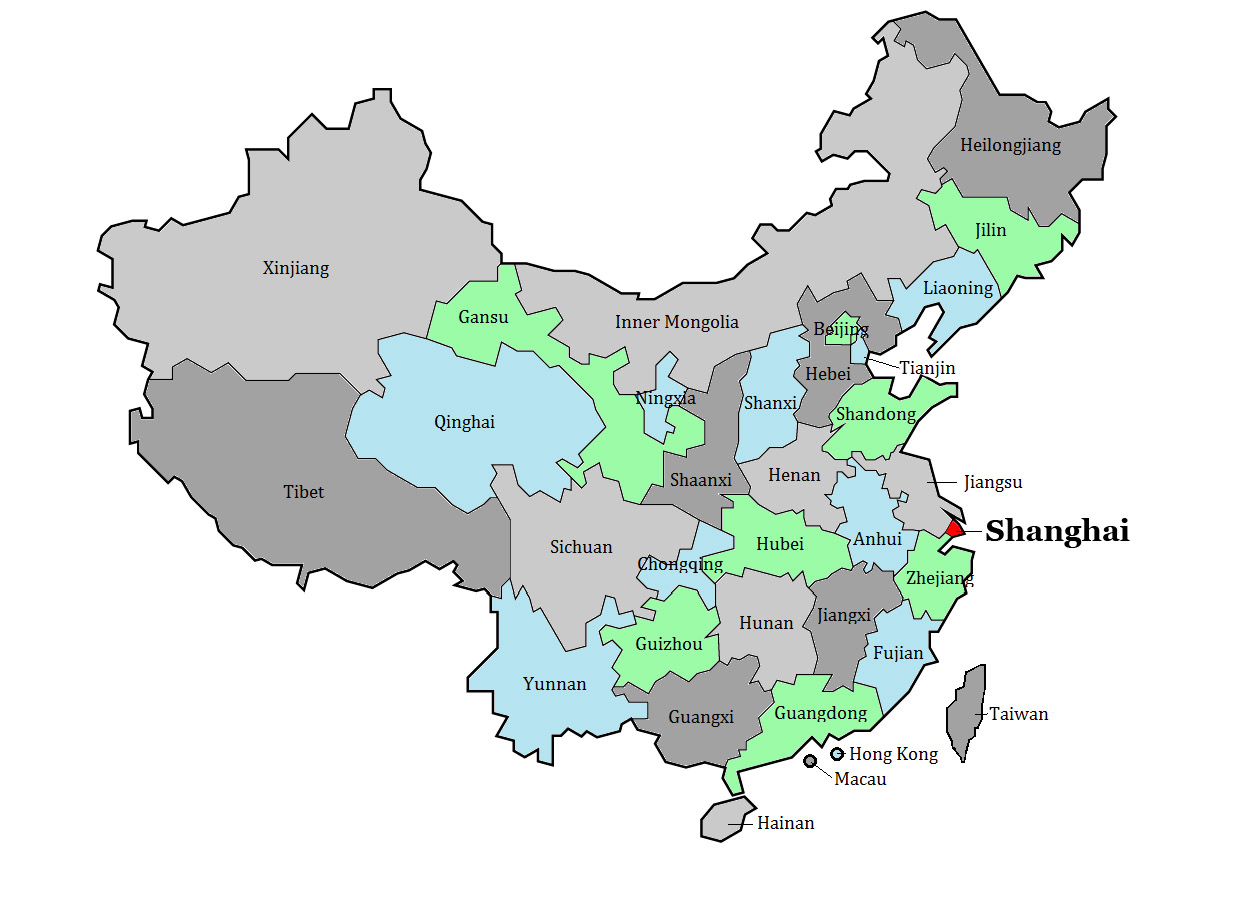Shanghai Municipality
Background
Shanghai Municipality is framed by Jiangsu the province to the north and west and Zhejiang the province to the southwest. Shanghai is situated on the coast of the East China Sea between the mouth of the Yangtze River to the north and the bay of Hangzhou to the south. The Municipality is comprised of 18 districts as well as several islands. The largest island – Chongming Island – has an area of 1267 km².
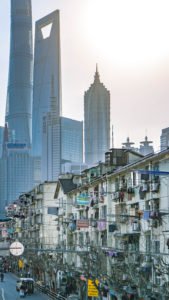
Archaeological records indicate that parts of Shanghai Municipality have been inhabited for almost 6000 years. Before the common era, the territory was settled by families and clans who were eventually consolidated under kingdoms, which rose and fell over the centuries. Most inhabitants were farmers, artisans and fishermen who took advantage of the region’s abundant rain, moderate climate and ample access to river and ocean fishing stocks. By the Tang and Song dynasties, the area developed into a significant trading port that conducted commerce primarily with people living along the Yangtze River and along the Chinese coast. Its economic importance was underscored when the Shanghai region was elevated from village to market town and 1074, when a customhouse was established, and when it was favored by infrastructure investment such as the building of sea walls designed to stabilize its ocean coastline. Shanghai’s industry grew with its trade, and by the Ming Dynasty an estimated 70% of arable land was dedicated to growing cotton which was then funneled into the city’s cotton and silk spinning industries which employed an estimated 20,000 weavers by the 1700s. Its position as a center of both trade and industry has meant that the city has always been a significant economic earner.
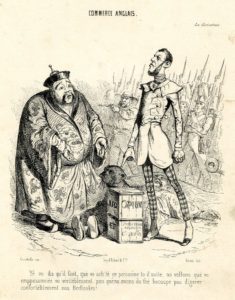
By 1554, a massive seawall – approximately 10 m high and 5 m in circumference-was built around the entire city to defend it from attacks by Japanese pirates. In 1684, when the Qing Dynasty withdrew the Ming Dynasty ban on ocean trading that had been in effect since 1525, Shanghai was well-positioned to prosper from the new economic opportunity. Further, by 1732, the city was granted exclusive control over customs collections for all foreign trade entering Jiangsu province. As a result, the city became the most significant port of the lower Yangtze region.
In 1842, after China’s defeat to Great Britain during the first Opium War, Shanghai was forced to open to unrestricted foreign trade. As a consequence, the British, French and Americans each took control of concessions of land in various areas of the city. In their concessions, the Western nations enjoyed extraterritorial privileges, much to the anger and humiliation of the Chinese. The Japanese received its Shanghai concession in 1895 after it defeated China during the first Sino-Japanese war. With the establishment of foreign concessions came European banks and other commercial houses further increasing the economic vitality of the city.
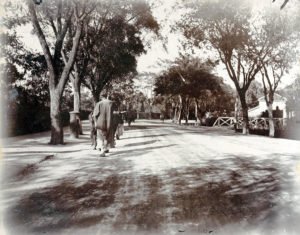
By 1860, Shanghai had become China’s most important harbor and accounted for an estimated 25% of total shipping tonnage entering and departing China. By 1890, various industries were created within the foreign concessions, leveraging Shanghai’s abundant and inexpensive labor and raw materials. By 1914, the old city walls were pulled down in order to make more room for Shanghai’s expanding factories and its growing domestic and international population.
In terms of international residents, during the 1920s and 1930s, an estimated 20,000 “White” Russians settled in Shanghai after fleeing Russia’s communist revolution. Additionally, during this period, an estimated 30,000 Jewish refugees from Europe also settled in the city. By 1932, it is estimated that the city housed as many as 70,000 foreigners and was one of the world’s largest cities. During this time of expansion, Shanghai became known by monikers such as “Paris of the East” and “Pearl of the Orient”. It was also called the “Whore of Asia” because of all the vice, corruption, drugs, and prostitution that expanded along with its population and industry.
The 1920s and 1930s was also a period of rising political cognizance for Chinese nationals, as Chinese citizens began more actively agitating to regain control of foreign concessions and to discover ways to bring China into the modern era as an equal participant in the international order. Shanghai was a hotbed of political activism and thinking. For instance, in 1921, the Chinese Communist Party was founded in the city with 53 members. In 1925, the city was the origin of the May 30th Uprising of students and workers who were protesting feudalism and foreign concessions; these protests quickly spread to other parts of China.

In 1932, in a prelude to the second Sino-Japanese War officially launched in 1937, fighting broke out between Chinese and Japanese nationals around the Japanese concession. During the “Shanghai Incident” is estimated that as many as 18,000 civilians were killed or injured. In 1937, Japan launched the second Sino-Japanese war. The war’s Battle of Shanghai resulted in the fall of Shanghai to Japanese occupation. During the battle, which lasted from August through October 1937, it is estimated that 60,000 Chinese and Japanese were killed or wounded. Chinese citizens trapped under Japanese occupation suffered greatly. In 1941, the Japanese conquered the remaining foreign concessions. In 1949, four years after the end of the second Sino-Japanese war, the People’s liberation Army of the Chinese Communist Party took control of the city.
Under Communist control, Shanghai returned to its role as an important economic generator for the nation, even during the tumultuous years of the Great Leap Forward and the Cultural Revolution. In 1990, Shanghai with able to participate in China’s nascent “reform and opening up”, and foreign capital began to once again flooded into the city. Today, Shanghai is China’s second most populous city in one of its most economically advanced.
People
In 2018, Shanghai had a population of over 24 million people, making it China’s 25th most populous region. The vast majority of its citizens are Han Chinese. It has been estimated that migrants originating from outside the municipality who lack permanent residence visas account for as much as 24-39% of the total population. Shanghai Municipality is China’s most populous city.
Economy
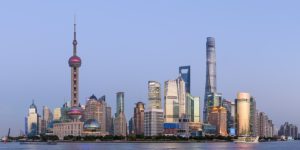
According to China’s National Bureau of Statistics, in 2018 Shanghai’s GDP was approximately $504 billion, the 10th largest in the country. Its per capita GDP was approximately $20,799. Overall, its GDP accounts for 3.8% of China’s total which was generated by 1.7% of China’s population. Its GDP per capita is ranked 4th out of China’s 33 provinces, municipalities, and autonomous regions. Shanghai’s primary industries accounted for approximately .4% of GDP, secondary industries 30.5% of GDP and tertiary industries 69.2% of GDP.
Historically, Shanghai has been an important industrial manufacturing base for China. In 2017, its most important industries included automotive manufacturing, computer, communications and other equipment, raw chemical materials and chemical products, petrochemicals, biomedicine, general equipment, electrical machinery equipment, smelting and pressing of ferrous metal, and special purpose equipment. Shanghai produced almost 3 million cars in 2017, and it is home to China’s largest steel maker. Shanghai is also China’s leading container port as well as being one of the largest container ports in the world.
Shanghai’s industrial base has been undergoing restructuring over the last decade. For instance, its share of low value-added manufacturing has declined markedly, particularly its production of textiles and heavy equipment manufacturing.
Tertiary activities generate the majority of Shanghai’s GDP. Its most important service industries in terms of revenue generation were financial services, retail and wholesale, and real estate. Going forward, Shanghai is committed to further developing its financial services base as well as expanding its logistics and cultural industries. In 2017, there were approximately banks, insurance companies and security companies residing within the municipality, about 250 of which were foreign invested.
In 2013, Shanghai became the test case for China’s first Pilot Free Trade Zone which offers preferential tax and other investment policies in order to attract foreign investment to various industries within the zone’s geographic area. Additionally, commodities entering the zone are exempt from duty and customs clearance. In 2017, Shanghai received approximately $17 billion in foreign direct investment. Shanghai is home to approximately 426 research and development centers.
Lay of the Land

DCIM100MEDIADJI_0211.JPG
Shanghai is located on the Huangpu River, a man-made tributary of the Yangtze River at the point where the Yangtze River Delta joins with the East China Sea. Over millennia, silt deposited by the Huangpu River and the Yangtze Delta have created the land on which Shanghai is situated. Over time, these alluvial deposits have been augmented by ambitious land reclamation efforts. The Municipality’s land is largely flat with an average elevation of just 4 m. Those hills that the city does have are in the municipality’s southwest. Its highest peak is 103 m, and is located on Dajinshan Island.
Shanghai is crisscrossed by a complex network of rivers, canals, streams and lakes and is famous for its abundant water resources; it is part of the Lake Tai drainage area. The center of Shanghai is divided by the Huangpu River. The historic center of the city is situated on the west side of the Huangpu near the mouth of Suzhou Rivers where it connects with Lake Tai and the Grand Canal. The newer central financial district has been built on Huangpu’s Eastern shore. From the confluence of the Huangpu and Suzhou Rivers, the city expands North West and South. Encompassing Shanghai’s central districts is a rural/suburban transitional zone which extends approximately 414 km.²
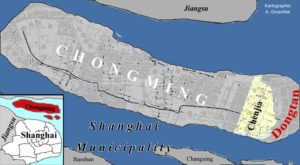
Shanghai also overseas numerous islands around its peninsula, including Chongming Island. Chongming Island has an area of 1267 km² and is mainland China’s second largest island after Hainan. Chongming Island is also Shanghai’s most northern point. Its next largest islands include Changxing at 89 km² and Hengsha at 56 km². These three islands are the only ones that house permanent residents. Shanghai’s remaining 19 uninhabited islands are generally small alluvial islands built up by silt deposited by the Yangtze River. In 2006, Shanghai’s coastland was approximately 309 km.
Interesting Aspects for Traveler

One of Shanghai’s most iconic landmarks is the Bund. The Bund was at the heart of colonial Shanghai, bracketed on one side by the Huangpu River and on the other side by hotels, banks, offices and clubs that were the extravagant symbols of Western economic power in the city. Most of these old buildings still exist, and it is architecturally interesting to observe their architectural styles and ornaments. Some of the most important buildings along the walk include: the Hong Kong and Shanghai Bank, the Customs House, the Russo-Asiatic Bank Building, the Former Bank of Taiwan, the North China Daily News Building, the Former Palace Hotel, the Peace Hotel and the Bank of China. Across the HuangPu River, the views of China’s new financial center are exceptional, especially at night when the modern skyline is spectacularly lit.
The People’s Park and Square -once a former racecourse- is an excellent place to watch locals exercise, walk and chat together. The park is surrounded by gleaming new glass and metal skyscrapers.

At its southern end is the Shanghai Museum. The Shanghai Museum’s is housed in the former racecourse clubhouse and has a collection of over 120,000 pieces including bronzes, ceramics, calligraphy, furniture, jade, ancient coins, paintings, seals, and sculptures. On its Eastern side is the Merciful Baptism Church which was constructed in 1929. Also worth a visit is the Shanghai Art Museum which houses the city’s contemporary Chinese art.
Shanghai’s Old Town -Nanshi- is one of the most authentic Chinese neighborhoods in the city. Its narrow winding lanes and historic homes are reminiscent of an older, more traditional China. Within the Old Town can be found the Yu Gardens and Bazaar. The Yu Gardens and Bazaar couples Ming Dynasty gardens that are believed to be more than 400 years old with a newly built restaurant and shopping center. The restaurant and shopping center has been constructed in an old-style manner which gives it a feeling of real in authenticity. The gardens themselves are divided by walls into six scenic areas. The surrounding shops sell everything from traditional medicines to souvenirs and tea. Street performers entertain crowds on the narrow streets and restaurants and tea houses offer delicious Chinese fare.
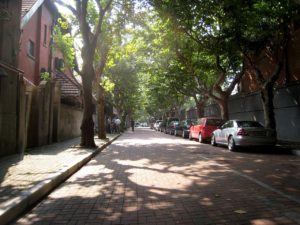
The former French Concession is centered today around Huaihai Lu -a lively street filled with boutiques, candy stores, salons, and bars as well as the trendy Jinjiang Hotel. The streets are characterized by shady canopies of Eurasian plane trees and is book ended by both the Zhongshan Park and the Xujiahui Park. The surrounding streets are vibrant at night with bars and clubs.
The Buddhist Jing’an Temple is one of Shanghai’s most revered places for ancestor worship. A temple has resided in the spot since the Three Kingdoms Period which lasted from 25-220 CE. The current buildings originate from the Ming and Qing Dynasties.

Another famous Shanghai Buddhist temple is the Jade Buddha Temple which is in the northwest part of the city. It was built in 1882 to house two beautiful Jade Buddha statues that were brought from Burma to Shanghai. After being closed for 30 years, it reopened in 1980, and today houses some 100 monks.
Hongkou Park is in the old Japanese concession. It is a lovely spot to watch locals and tourists taking boat rides, playing chess, practicing Qi Gong or simply relaxing.
Song Qingling’s Former Residence, located at the southwestern edge of the city, is a beautiful villa originally belonging to Song Qingling, wife of the revolutionary leader Dr. Sun Yatsen. The house is an excellent example of mid-20th century Shanghai villa architecture, replete with wood paneling and lacquer work.
To the west and north of Shanghai are a series of towns situated along the length of China’s ancient Grand Canal that make wonderful day trips. An example of such a city is Suzhou, a historic town filled with gardens, pagodas, silk works, waterways, and ancient moats. The Grand Canal winds its way through the town’s center. The city includes beautiful classic gardens.

